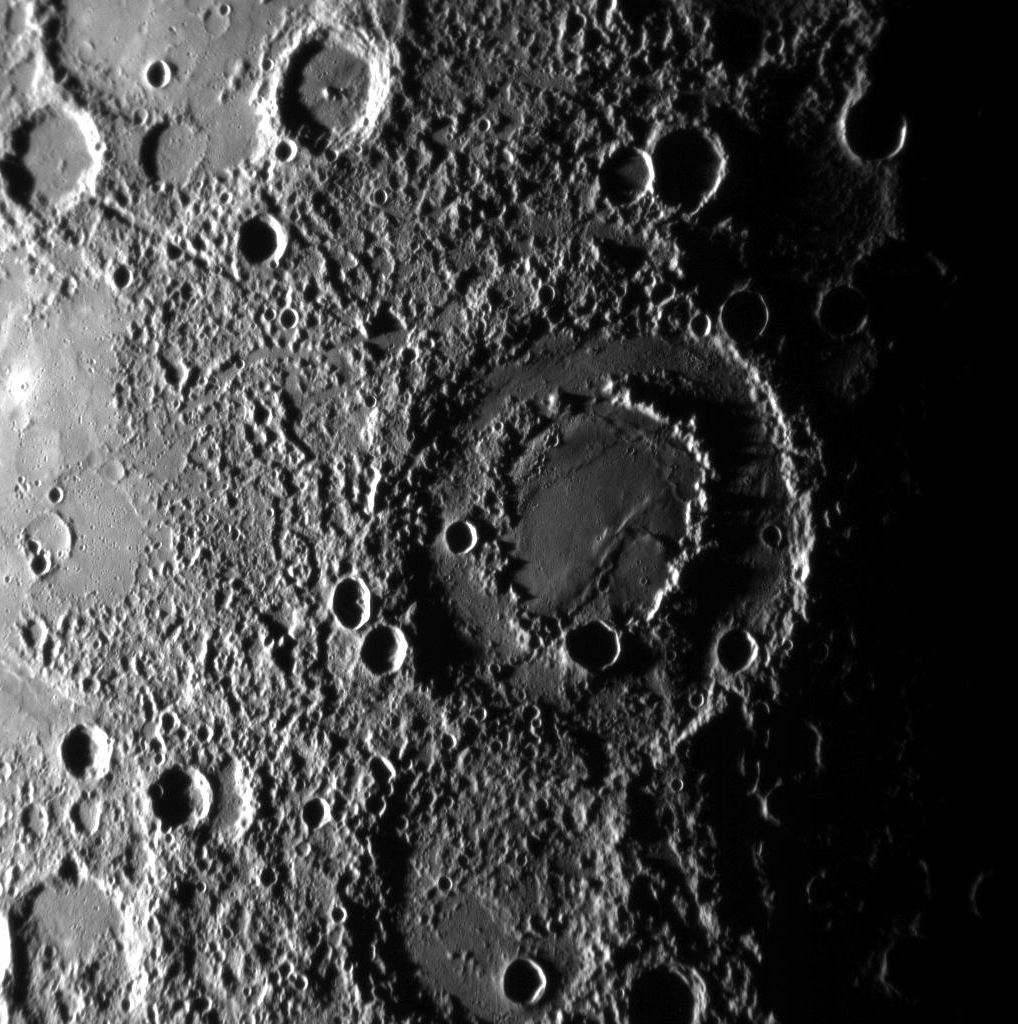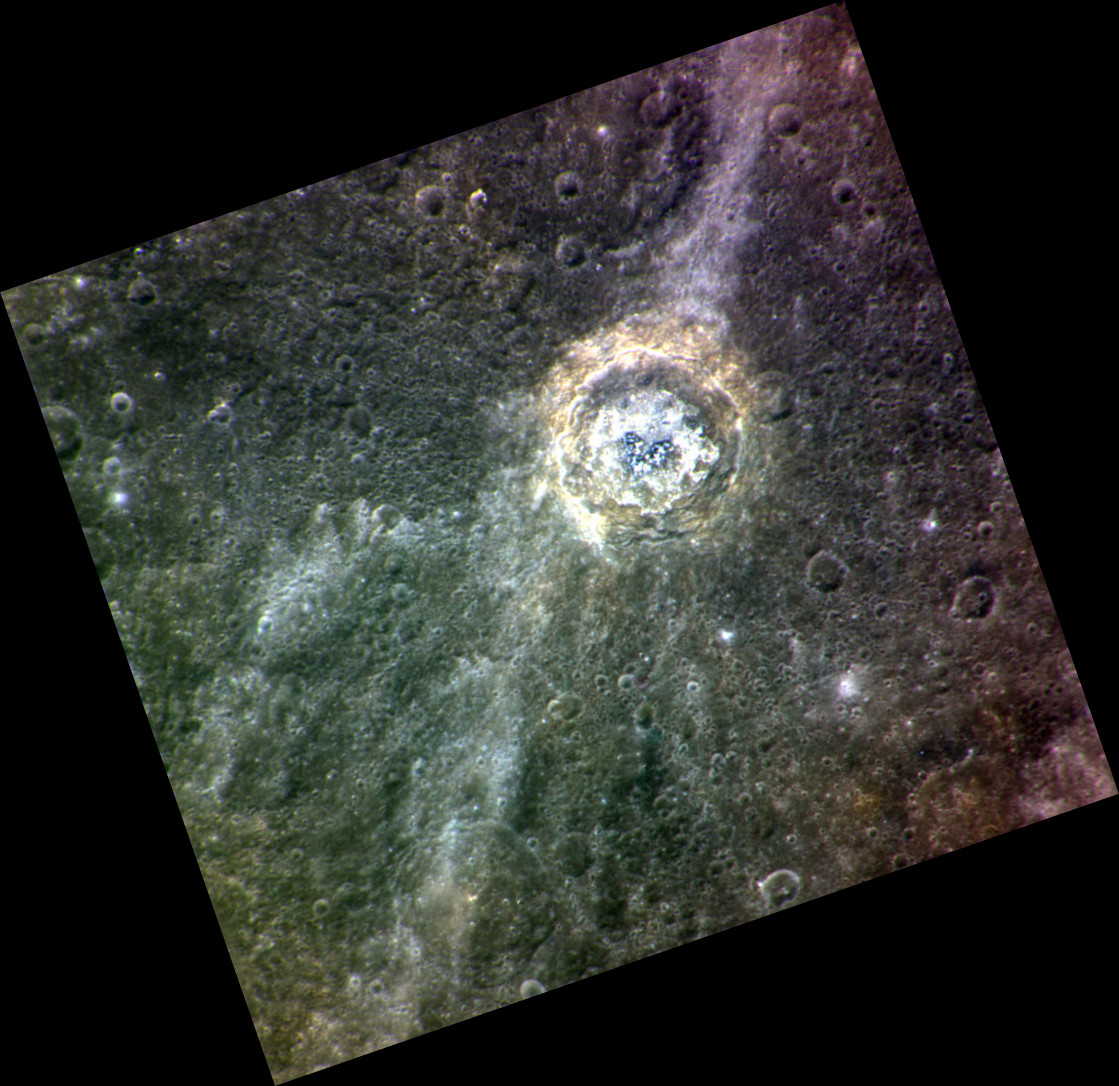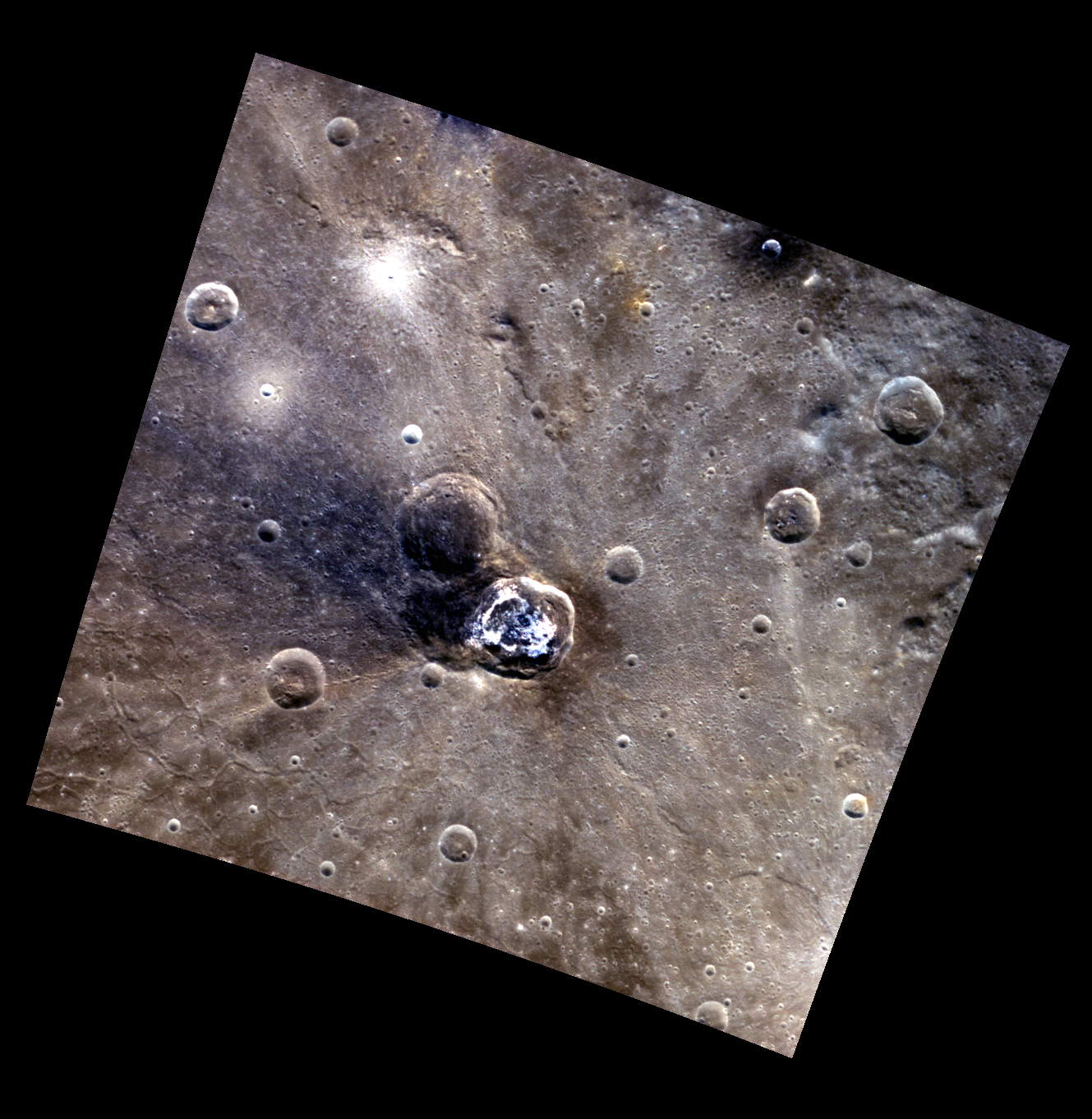|
Hollows (Mercury)
Hollows are a landform on the planet Mercury, discovered during the '' MESSENGER'' mission that orbited the planet from 2011 to 2015. Hollows are typically clusters of rimless depressions with flat floors and haloes of bright (high albedo) material surrounding them. Hollows are thought to form by loss of volatiles from the surface by sublimation, caused by the intense solar radiation on the airless planet. They are some of the youngest features on Mercury. Hollows were first observed as bright areas within craters imaged by the Mariner 10 spacecraft in 1974, but the images were not of sufficient resolution to discern any detail. These craters include Balzac, Tyagaraja, Theophanes, Zeami, and Hopper.Dzurisin, D., 1977. Mercurian bright patches: Evidence for physio-chemical alteration of surface material? ''Geophysical Research Letters'', 4, 383-386, doi:10.1029/GL004i010p00383 The MESSENGER spacecraft imaged the rest of the planet, much of it at higher resolution and in co ... [...More Info...] [...Related Items...] OR: [Wikipedia] [Google] [Baidu] |
Mercury (planet)
Mercury is the smallest planet in the Solar System and the closest to the Sun. Its orbit around the Sun takes 87.97 Earth days, the shortest of all the Sun's planets. It is named after the Roman god ' ( Mercury), god of commerce, messenger of the gods, and mediator between gods and mortals, corresponding to the Greek god Hermes (). Like Venus, Mercury orbits the Sun within Earth's orbit as an inferior planet, and its apparent distance from the Sun as viewed from Earth never exceeds 28°. This proximity to the Sun means the planet can only be seen near the western horizon after sunset or the eastern horizon before sunrise, usually in twilight. At this time, it may appear as a bright star-like object, but is more difficult to observe than Venus. From Earth, the planet telescopically displays the complete range of phases, similar to Venus and the Moon, which recurs over its synodic period of approximately 116 days. The synodic proximity of Mercury to Earth makes Mercury most ... [...More Info...] [...Related Items...] OR: [Wikipedia] [Google] [Baidu] |
Lermontov (crater)
Lermontov is an impact crater on the planet Mercury. The crater is named after Mikhail Yuryevich Lermontov, a 19th-century Russian poet. The name was approved by the International Astronomical Union in 1976. The crater floor is somewhat brighter than the exterior surface and is smooth with several irregularly shaped depressions. Such features, similar to those found on the floor of Praxiteles, may be evidence of past explosive volcanic activity on the crater floor. Lermontov appears reddish in enhanced-color views, suggesting that it has a different composition from the surrounding surface. To the north of Lermontov are Proust and Bek craters. To the south is Chaikovskij, and to the southwest is Giotto Giotto di Bondone (; – January 8, 1337), known mononymously as Giotto ( , ) and Latinised as Giottus, was an Italian painter and architect from Florence during the Late Middle Ages. He worked during the Gothic/Proto-Renaissance period. Giot .... Views Mariner 10 ima ... [...More Info...] [...Related Items...] OR: [Wikipedia] [Google] [Baidu] |
Pasch (crater)
Pasch is a crater on Mercury. Its name was adopted by the International Astronomical Union (IAU) in 2012. Pasch is named for the Swedish painter Ulrika Pasch. Pasch is located northwest of the Caloris basin, and north of the plains of Mearcair Planitia Mearcair Planitia is a large plain on the planet Mercury. The name Mearcair is the Irish word for "Mercury", and the name was approved in 2017. It was first observed in detail by MESSENGER. It lies between the large crater Raditladi and the a .... Hollows Hollows are present on the central peak complex, floor, and walls of Pasch crater. Pasch crater hollows EN0215894066M.jpg, View of central peak complex looking southeast Pasch crater hollows EN0220806909M.jpg, Similar view looking east References {{Mercury (planet) Impact craters on Mercury ... [...More Info...] [...Related Items...] OR: [Wikipedia] [Google] [Baidu] |
Geology Of Mercury
The geology of Mercury is the scientific study of the surface, crust, and interior of the planet Mercury. It emphasizes the composition, structure, history, and physical processes that shape the planet. It is analogous to the field of terrestrial geology. In planetary science, the term ''geology'' is used in its broadest sense to mean the study of the solid parts of planets and moons. The term incorporates aspects of geophysics, geochemistry, mineralogy, geodesy, and cartography. Historically, Mercury has been the least understood of all the terrestrial planets in the Solar System. This stems largely from its proximity to the Sun which makes reaching it with spacecraft technically challenging and Earth-based observations difficult. For decades, the principal source of geologic information about Mercury came from the 2,700 images taken by the Mariner 10 spacecraft during three flybys of the planet from 1974 to 1975. These images covered about 45% of the planet’s surface, bu ... [...More Info...] [...Related Items...] OR: [Wikipedia] [Google] [Baidu] |
Mansur (crater)
Mansur is a crater on Mercury. Its name was adopted by the International Astronomical Union in 1979. Mansur is named for the Indian artist Ustad Mansur Ustad Mansur (flourished 1590-1624) was a seventeenth-century Mughal painter and court artist. He grew up during the reign of Jahangir (r. 1605 - 1627) during which period he excelled at depicting plants and animals. He was the earliest artist t ..., who lived in the 17th century CE. The Mansurian time period on Mercury is named after Mansur crater. The time of its impact does not denote the start of the period, but the crater is an excellent example of a Mansurian crater. Views File:Mariner 10 image 0000188.png, Mariner 10 image with Mansur crater near center File:Mansur crater MESSENGER WAC IGF to RGB.jpg, Approximate color image from MESSENGER File:Mansur crater hollows EN1052702086M.jpg, Detail of the hollows near the northern crater rim File:Mansur crater central peaks EN1040083977M.jpg, The central peak complex ... [...More Info...] [...Related Items...] OR: [Wikipedia] [Google] [Baidu] |
De Graft (crater)
De Graft is a crater on Mercury. Its name was adopted by the International Astronomical Union in 2009, after Ghanaian playwright, poet, and novelist Joe de Graft. Much of the floor of de Graft is covered in hollows. De Graft is one of the largest craters of the Kuiperian system on Mercury. The largest is Bartók crater.Denevi, B. W., Ernst, C. M., Prockter, L. M., and Robinson, M. S., 2018. The Geologic History of Mercury. In ''Mercury: The View After MESSENGER ''MESSENGER'' was a NASA robotic space probe that orbited the planet Mercury between 2011 and 2015, studying Mercury's chemical composition, geology, and magnetic field. The name is a backronym for "Mercury Surface, Space Environment, Geoche ...'' edited by Sean C. Solomon, Larry R. Nittler, and Brian J. Anderson. Cambridge Planetary Science. Chapter 6, Table 6.4. References Impact craters on Mercury {{Mercury-planet-stub ... [...More Info...] [...Related Items...] OR: [Wikipedia] [Google] [Baidu] |
Kuiper (Mercurian Crater)
Kuiper is a moderate-size crater with a central peak cluster located at on Mercury. It is 62 kilometers in diameter and was named after Dutch-American astronomer Gerard Kuiper in 1976. It is one of only 2 Mercurian craters which are named not after artists, and one of very few cases when the same name is used for 3 craters (there are also Kuiper craters on Mars and on the Moon). Gerard Kuiper, being a leader of American planetary science, died shortly before the first images of Mercurian surface were made. Kuiper overlies the northern rim of the larger crater Murasaki. Kuiper crater has the highest recorded albedo of any region on the planet's surface and has a prominent ray system, suggesting that it is one of the youngest craters.Description Kuiper is one of the largest craters of the Kuiperian system on Mercury. The largest is Bartók crater.Denevi, B. W., Ernst, C. M., Prockter, L. M., and Robinson, M. S., 2018. The Geologic History of Mercury. In ''Mercury: The V ... [...More Info...] [...Related Items...] OR: [Wikipedia] [Google] [Baidu] |
Canova (crater)
Canova is a crater on Mercury. Its name was adopted by the International Astronomical Union The International Astronomical Union (IAU; french: link=yes, Union astronomique internationale, UAI) is a nongovernmental organisation with the objective of advancing astronomy in all aspects, including promoting astronomical research, outreac ... (IAU) in 2018, after Italian sculptor Antonio Canova. Hollows are present within the crater and to the northwest of it. References Antonio Canova Impact craters on Mercury {{Mercury-planet-stub ... [...More Info...] [...Related Items...] OR: [Wikipedia] [Google] [Baidu] |
Caloris Planitia
Caloris Planitia is a plain within a large impact basin on Mercury, informally named Caloris, about in diameter. It is one of the largest impact basins in the Solar System. "Calor" is Latin for "heat" and the basin is so-named because the Sun is almost directly overhead every second time Mercury passes perihelion. The crater, discovered in 1974, is surrounded by the Caloris Montes, a ring of mountains approximately tall. Appearance Caloris was discovered on images taken by the '' Mariner 10'' probe in 1974. Its name was suggested by Brian O'Leary, astronaut and member of the ''Mariner 10'' imagery team. It was situated on the terminator—the line dividing the daytime and nighttime hemispheres—at the time the probe passed by, and so half of the crater could not be imaged. Later, on January 15, 2008, one of the first photos of the planet taken by the ''MESSENGER'' probe revealed the crater in its entirety. The basin was initially estimated to be about in diameter, though ... [...More Info...] [...Related Items...] OR: [Wikipedia] [Google] [Baidu] |
Balanchine (crater)
Balanchine is a crater on the planet Mercury. It possesses a ray system of slightly bluish rays. These rays inspired the name of the crater due to their similarity to the tutu in George Balanchine's ''Serenade''. Extensive Hollows are present within Balanchine. Balanchine lies in the northeast portion of the Caloris Basin. To the northeast of Balanchine is Nervo crater, and to the southeast is March March is the third month of the year in both the Julian and Gregorian calendars. It is the second of seven months to have a length of 31 days. In the Northern Hemisphere, the meteorological beginning of spring occurs on the first day of March .... References External links Image of the crater {{Mercury (planet) Impact craters on Mercury Raditladi quadrangle ... [...More Info...] [...Related Items...] OR: [Wikipedia] [Google] [Baidu] |
Nāwahī (crater)
Nāwahī is a Impact crater, crater on Mercury (planet), Mercury. Nāwahī crater is located within the large Caloris Planitia, Caloris basin, near the western rim. The unusual dark material creating a halo around Nāwahī makes this crater of special interest, as the dark material likely represents rocks with a different chemical and mineralogical composition than those of the neighboring surface. The crater is named after Hawaiian patriot and painter Joseph Nāwahī. Hollows (Mercury), Hollows are present in Nāwahī, mostly along the terraces of the crater rim. A confirmed ''dark spot'' is present in Nāwahī.Zhiyong Xiao, Robert G. Strom, David T. Blewett, Paul K. Byrne, Sean C. Solomon, Scott L. Murchie, Ann L. Sprague, Deborah L. Domingue, Jörn Helbert, 2013. ''Dark spots on Mercury: A distinctive low-reflectance material and its relation to hollows''. Journal of Geophysical Research Planets.doi.org/10.1002/jgre.20115/ref> This dark spot is associated with the hollows. ... [...More Info...] [...Related Items...] OR: [Wikipedia] [Google] [Baidu] |
Sander (crater)
Sander is a crater on Mercury within Caloris Basin Caloris Planitia is a plain within a large impact basin on Mercury, informally named Caloris, about in diameter. It is one of the largest impact basins in the Solar System. "Calor" is Latin for "heat" and the basin is so-named because the Sun .... It has dark walls and bright patches on its floor. Unlike the rays of Bashō crater, the bright areas are not believed to be immature, but they are inherently bright. It is named after the German photographer August Sander (1876–1964). Hollows are present within Sander. A confirmed ''dark spot'' is present in Sander.Zhiyong Xiao, Robert G. Strom, David T. Blewett, Paul K. Byrne, Sean C. Solomon, Scott L. Murchie, Ann L. Sprague, Deborah L. Domingue, Jörn Helbert, 2013. ''Dark spots on Mercury: A distinctive low-reflectance material and its relation to hollows''. Journal of Geophysical Research Planets.doi.org/10.1002/jgre.20115/ref> This dark spot is associated with the ... [...More Info...] [...Related Items...] OR: [Wikipedia] [Google] [Baidu] |





